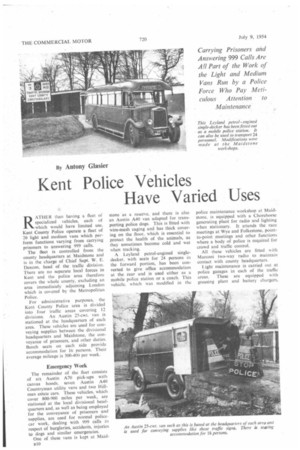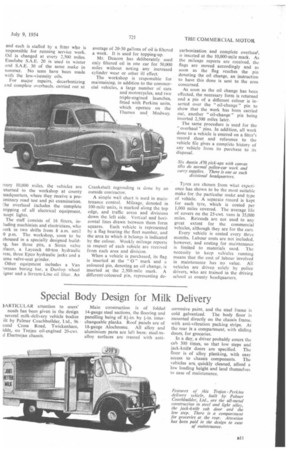Kent Police Vehicles Have Varied Uses
Page 44

Page 45

If you've noticed an error in this article please click here to report it so we can fix it.
RATHER than having a fleet of specialized vehicles, each of which would have limited use. Kent County Police operate a fleet of 20 light and medium vans which perform functions varying from carrying prisoners to answering 999 calls.
The fleet is controlled from the county headquarters at Maidstone and is in the charge of Chief Supt. W. E. Deacon, head of the traffic division. There are no separate local forces in Kent and the police area therefore covers the whole county, excluding an area immediately adjoining London which is covered by the Metropolitan Police.
For administrative purposes, the Kent County Police area is divided into four traffic areas covering 12 divisions. An Austin 25-cwt. van is stationed at the headquarters of each area. These vehicles are used for conveying supplies between the divisional headquarters and Maidstone, the conveyance of prisoners, and other duties. Bench seats on each side provide accommodation for 16 persons. Their average mileage is 300-400 per week.
Emergency Work
The remainder of the fleet consists of six Austin A70 pick-ups with canvas hoods, seven Austin A40 Countryman utility vans and two Hillman estate cars. These vehicles, which cover 800-900 miles per week, are stationed at the local divisional headquarters and, as well as being employed for the conveyance of prisoners and supplies, are used for normal policecar work, dealing with 999 calls in respect of burglaries, accidents, injuries to dogs and similar emergencies.
One of these vans is kept at MaidB10 stone as a reserve, and there is also an Austin A40 van adapted for transporting police dogs. This is fitted with wire-mesh caging and has thick covering on the floor, which is essential to protect the health of the animals, as they sometimes become cold and wet when tracking.
A Leyland petrol-engined singledecker, with seats for 24 persons in the forward portion, has been converted to give office accommodation at the rear and is used either as a mobile police station or a coach. This vehicle, which was modified in the police maintenance workshop at Maidstone, is equipped with a Chorehorse generating plant for radio and lighting when stationary. It attends the race meetings at Wye and Folkestone, pointto-point meetings and other functions where a body of police is required for crowd and traffic control.
All these vehicles are fitted with Marconi two-way radio to maintain contact with county headquarters.
light maintenance is carried out at police garages in each of the traffic areas. These are equipped with greasing plant and battery chargers, and each is staffed by a fitter who is responsible for running service work. Oil is changed at every 2,500 miles. Essolube S.A.E. 20 is used in winter and S.A.E. 30 of the same make in summer. No tests have been made with the low-viscosity oils.
For major repairs, decarbonizing and complete overhauls carried out at
:very 10,000 miles, thc vehicles are .etumed to the workshop at county teadquarters, where they receive a preiminary road test and pit examination. rhe overhaul includes the complete tripping of all electrical equipment, xcept
The staff consists of 16 fitters, inluding machinists and electricians, who vork in two shifts from 8 am. until 0 p.m. The workshop, soon to be ehoused in a specially designed buildig, has three pits, a Sioux valve :facer, a Laycock 60-ton hydraulic ress, three Epco hydraulic jacks and a uma valve-seat grinder.
Other equipment includes a Van rorman boring bar, a Dunlop wheel igner and a Stream-Line oil filter. An average of 20-30 gallons of oil is filtered a week. It is used for topping-up.
Mr. Deacon has deliberately used only filtered oil in one car for 50,000 miles without noting any increased cylinder wear or other ill effect.
The workshop is responsible for maintaining, in addition to the commercial vehicles, a large number of cars and motorcycles, and two triple-engined launches, fitted with Perkins units, which operate on the Thames and Medway.
Crankshaft regrinding is done by an outside contractor.
A simple wall chart is used in maintenance control. Mileage, denoted in 100-mile units, is marked along the top edge, and traflic areas and divisions down the left side. Vertical and horizontal lines drawn between them form squares. Each vehicle is represented by a flag bearing the fleet number, and the area to which it belongs is indicated by the colour. Weekly mileage reports in respect of each vehicle are received from each area and division.
When a vehicle is purchased, its flag is inserted at the " 0 " mark and a coloured pin, denoting an oil change, is inserted at the 2,500-mile mark. A different-coloured pin, representing de
carbonization and complete overhaul, is inserted at the 10,000-mile mark. As the mileage reports are received, the flags are moved accordingly and as soon as the flag reaches the pin denoting the oil change, an instruction to have this done is sent to the area concerned.
As soon as the oil change has been effected, the necessary form is returned and a pin of a different colour is inserted over the " oil-change " pin to show that the work has been carried out, another " oil-change" pin being inserted 2,500 miles later.
The same procedure is used for the " overhaul " pins. In addition, all work done to a vehicle is entered on a fitter's record sheet and reference to the vehicle file gives a complete history of any vehicle from its purchase to its disposal.
Tyres are chosen from what experience has shown to be the most suitable make for the particular make and type of vehicle. A separate record is kept for each tyre, which is costed per 1,000 miles covered. The average life of covers on the 25-cwt. vans is 35,000 miles. Retreads are not used to any great extent for the commercial vehicles, although they are for the cars.
Every vehicle is costed every three months. Labour costs are not included, however, and costing for maintenance is limited to materials used. The necessity to keep vehicles running means that the cost of labour involved in maintenance has no value. All vehicles are driven solely by police drivers, who are trained in the driving school at county headquarters.




























































































